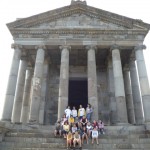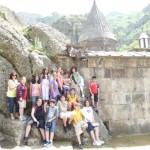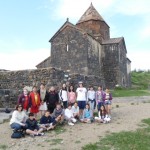May 30, 2010
Today is Sunday May 30. This morning on our way to Garni we saw the statues of Hayk Nahabed and Vahagen choking a dragon. We arrived in Garni, which is one of the biggest and oldest village in Hayastan. The gate at Garni was locked so Mariam, our guide, had the gates opened for us.
Garni was originally a Pagan temple built in 77 B.C. It was built on top of a hill surrounded on two sides by gorges and one side had a fortress wall. The walls were 6 feet thick by 60 feet high. It also had 14 towers built into the wall. We saw lots of mountains and rivers that ran through the gorges. The temple was built using steel spikes and lead without any cement. Inside there was a hole in the middle and a temple in the back side of the small hall. We saw a man playing a duduk there also.
Next to the temple was a bath house that was built by Greek slaves. They had built the bath house and were not paid so they made a mosaic that said “We built this but were not paid”. The floor of the bath house was built on columns. This way they could put hot water underneath to keep the floors warm. Behind the bath house were ruins of a palace originally built in the 7th century.
Next we went to Geghard Monastery which is in the Kotayk region. This monastery was built into the mountain side. It looks like one church but it has three churches on the inside. Inside one of churches was a water pool that turned into a stream. There is a legend that says if a women drinks the water they become pregnant.
We had lunch at a family’s backyard that they had made into a restaurant. When we walked in there was a lot of smoke everywhere because they were cooking our food. The food was so good. There was chicken, potatoes, and fish. They cooked our lunch in a pit. They also made lavash bread and we saw how they made it. It was really yummy.
On our way to Sevan we were on a highway which was a nice change because most of the other roads were very bumpy. In Sevan we went to the Sevan Armenian Learning Center. This is an afterschool program for the local kids. We spent an hour with them playing games and some of the kids exchanged email addresses to keep in touch. We gave them backpacks with our schools logo on it and they gave us goody bags with pictures, their artwork and little booklets.
After this we went to Lake Sevan. We visited the two churches on a small mountain that used to be an island but is not anymore. It is now connected to the mainland because the water level had dropped when they started using the water to make electricity. Now there are stairs to get to the two churches on top of the mountain. The two churches are known as Stepanavank. One is in use and the other is not. We lit candles in the church and took a lot of pictures there overlooking the lake.
Sevan lake is 1900 meters above sea level and is 78 meters long. It has two sections but is not separated. Some of our group walked into the water and it was really cold. Most of us also collected sand and water from the beach there.
On our way back we drove past the monument of Hayk Nahabed. Hayastan was named after him. He fought against Pel and shot an arrow with three feathers that went through the shield of Pel.
Dinner was at Lagonid and we had a traditional Middle Eastern dinner of Hummus, Tabouleh, Baba Ganoush, Lahmejune, and Chicken.
ByLori Shirinian and Garen Soukiasian


